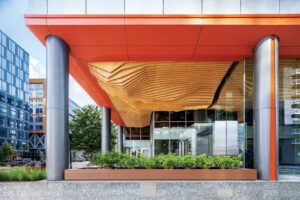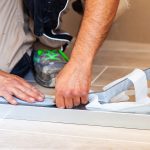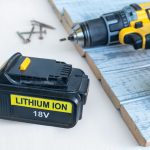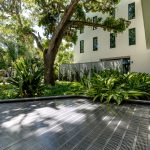
As metal becomes more ubiquitous in the architectural market due to its inherent benefits, there has been a new demand for innovative and custom finishes.
Considered and contextual metals can have a visceral and emotive influence on a project, often being as impactful as the form itself. The development of ultra high-performance aluminum (UHPA) was intended exactly for this—to focus on the intersection of design, performance, and sustainability while giving architects more options to work with.
Previously, coatings were limited by gloss levels and color ranges, often devoid of complex designs. However, this increased demand has pushed manufacturers to produce innovative and beautiful solutions.
Clear-coat metals
Clear coat is a new technology in which a colorfast translucent layer is applied on top of raw aluminum before the finishing process, highlighting the beautiful glint and luster the material naturally possesses. By infusing the aluminum with copper or gold pearlescent inks, the reflected light becomes warmer, creating a new depth to typical metal panels. These surfaces are excellent for projects that need to capture innate glow of brass, bronze, copper, or weathering steel—without the legacy of maintenance. Since all the layers are injected with a high-performing fluoroethylene vinyl ether (FEVE) resign, the surface will stay colorfast without chalking or fading for generations to come.
Gloss-matte and physically textured metals
By combining multiple overlays with different gloss levels, surfaces can now feature physical and optical depth, closely replicating masonry materials like concrete, stone, and terra cotta. Allowing surfaces to be super matte also allows them to reflect light in a diffuse manner, making them appear more substantial.
Graphic overlays
There has been recent interest from designers to create more graphic images, which provide a more semiotic interpretation of metal surfaces. One architectural firm worked with a manufacturer to match the color and gloss of the original solid polyvinylidene fluoride (PVDF) resin finish but contemporized the surface with a tech-inspired geometric “frit,” which sits proudly on the terra cotta pigment. The custom pattern was sent to the manufacturer from the architect via PDF and digitally engraved into the cylinder to match the scale and contrast desired. The result is a retro industrial surface.
Installation benefits
Given these innovations in finishing, aluminum is now an amazing replacement for many natural materials when cost, weight, or lead times are an issue. The spans can also be much greater in metal, meaning it can be easier to match the architect’s initial design intent.
These attributes greatly impact the bottom line, as they translate to faster installation times due to weight and size, and, therefore, lower labor costs. Further, these materials can be easily preassembled in an installation facility. All this leads to huge transportation savings.
Sustainability
From a green standpoint, aluminum is always an excellent choice. Single-skin material is inherently noncombustible and 100 percent recyclable, and it can contain high levels of recycled content. Further, the use of FEVE resin and organic pigments and inks ensure these materials meet the highest standards, such as Red List.
Conclusion
Custom UHPA coatings focus on the intersection between functionality, sustainability, and design, breaking away from the banal to create something meaningful and beautiful. These innovative coatings are changing the landscape of facade possibilities, allowing the simplicity of metal to match the beauty of natural materials like brass, bronze, stone, concrete, wood, and even frit glass.
Geoff Hahn is creative director at Pure + FreeForm. He is a metals and materials designer best known for his design work over the last decade and a half with leading organizations and brands.





